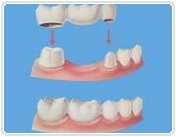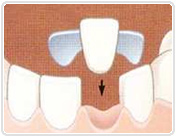Appearance is another important reason for wearing a bridge, which helps to support your lips and cheeks. A missing tooth may cause your mouth to sink and your face to look older. Missing teeth can also cause speech disorders since they are used to make many of the sounds we use to speak clearly.
How is a bridge attached?
Constructing and attaching a bridge typically requires two or three appointments. At the first appointment we will prepare the teeth on either side of the space by removing a portion of the enamel and dentin. Since the bridge must be fabricated very precisely to ensure correct bite and to match the opposing tooth, impressions of the teeth are taken and sent to a lab where the bridge will be constructed. Fixed bridges are typically cemented to the natural teeth next to the space left by the missing tooth. A pontic (false tooth) replaces the lost tooth. Crowns, which are permanently attached to your natural teeth, provide support for the bridge.
What materials are used?
Bridges can be constructed from gold alloys, non-precious alloys, porcelain, or a combination of these materials. Porcelain is often bonded to either precious or non-precious metal.
How do I take care of my bridge?
A strict recommend of brushing and flossing, using combind floss threader will keep the bridge and surrounding teeth clean. This is vital since the bridge relies on the neighboring teeth for support.




